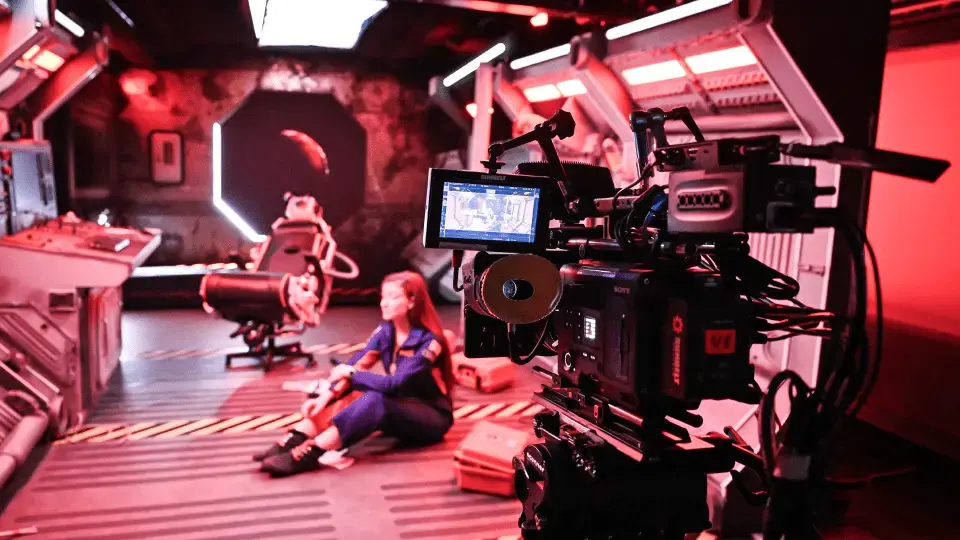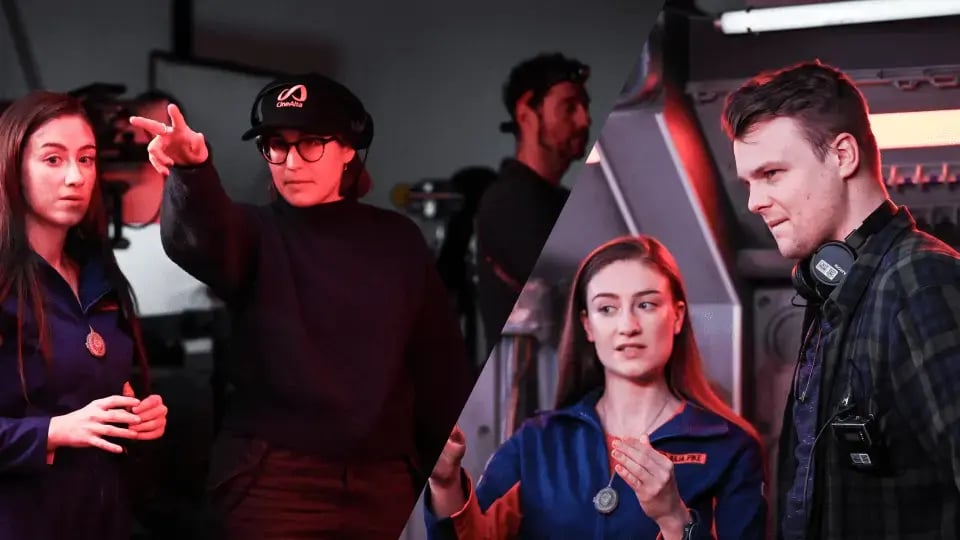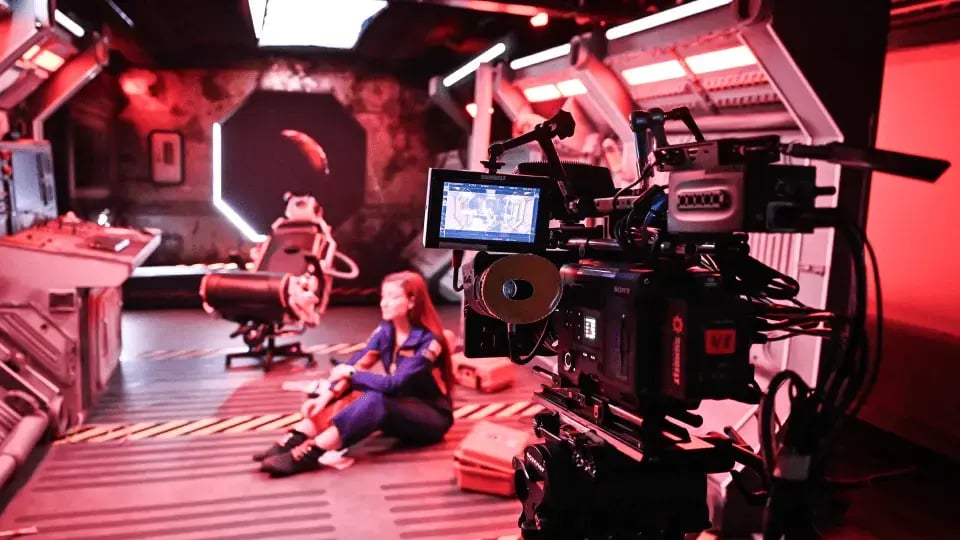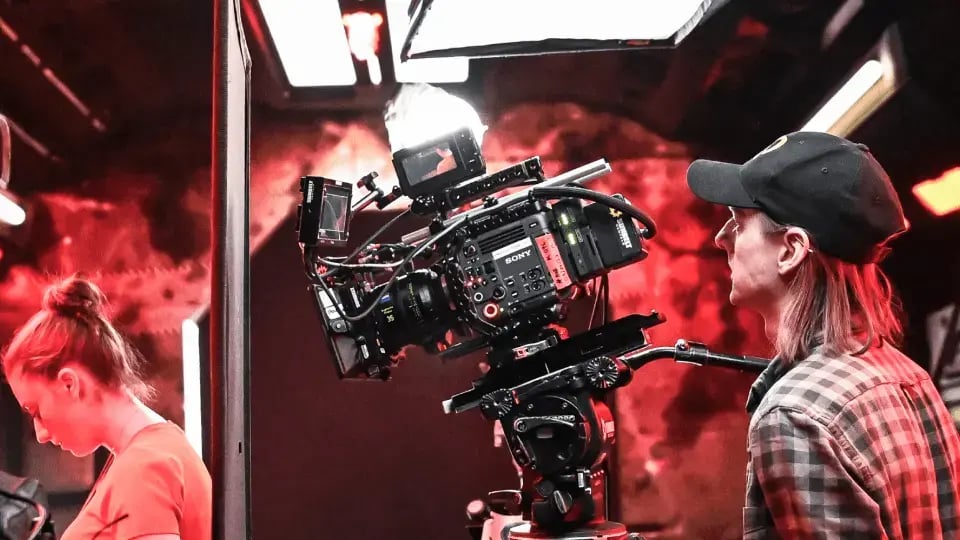
Created in just 16 weeks with only two days of shooting, Hestia—a collaboration between Red Robin Films and Sony | Professional Europe—serves as both a tech demo and a case study of Sony's cutting-edge Crystal LED VERONA display system and the Sony BURANO and VENICE 2 digital cinema cameras.
I was recently invited to a screening of Hestia to report on a project that showcases the potential of Sony's latest virtual production technology while providing a fantastic opportunity for a young filmmaking duo.
Hestia trailer
What I found was more than just a showcase of gadgetry, however. It was a testament to what can happen when passionate storytellers are given access to tools that were once the sole province of blockbuster productions.
Leaving the event, it struck me that I had two stories to tell; one about human connection and collaborative creativity and another about technological innovation in filmmaking.
In the spirit of Hestia itself, which blends the human and the technological so effectively, I decided to tell both stories in one article.
- Make me feel something! Read the human section.
- Give me the tech details! Jump to the technology showcase.
Part One
When storytelling meets technology
Something I did not expect, as I sat in the dark screening room surrounded by industry professionals, was to find a tear rolling down my cheek. But there it was. As a father of two young daughters, the story of a parent saying a final goodbye to her child resonated deeply.
This impact is a testament to both the filmmakers' storytelling prowess and the seamless integration of the cutting-edge virtual production technology. If the story had not been built upon an emotional core, or the virtual production tech had been glaringly apparent, then it's unlikely the film would have hit on a storytelling level. The fact that it did is the greatest compliment I can give in both aspects.
The blending of emotion and technology isn't just apparent in the final product—it's woven throughout the entire project. At its core, the 12-minute Hestia is a testament to the power of collaboration. It's a fusion of heartfelt storytelling and cutting-edge technology, each elevating the other.
It's also the synergy between co-directors Isobel Drane and Kieran Lowley; Drane focusing on narrative and performance, Lowley on technical execution and VFX—allowing their diverse strengths to form a cohesive vision.
And perhaps most strikingly, it's the partnership between Sony, a monolithic creator of filmmaking technology, and Red Robin Films, a rising star in the production world.
"Working with Sony felt like a dream," Lowley says. "Here was a chance to tell a story we were passionate about, using technology we'd only dreamed of accessing." This sentiment echoes throughout the project from everyone I speak with.

Co-directors Isobel Drane & Kieran Lowley on set with lead actor Amber Doig-Thorne
The catalyst for this dream-like collaboration was Chris Couzens, UK Channel Manager for Virtual Production & CINE at Sony. Couzens saw an opportunity not just to test Sony's technology, but to empower filmmakers to tell a compelling story in the process.
His vision went beyond a mere tech demo; he wanted to showcase how cutting-edge tools could enhance and serve creativity rather than overshadow it.
This collaborative spirit extended to the production process itself. Despite the daunting challenge of a 16-week turnaround with only two days of on-set filming, multiple crew members described it as one of the smoothest productions they'd ever experienced.
An extensive pre-production process allowed everyone to arrive on set with a clear directive. This safety net of knowing precisely what had to be done allowed an environment open to what could be done, with anyone on set encouraged to share impromptu ideas or not yet considered solutions.
This willingness to push boundaries and find the best path forward extended to the Sony technical team managing the production facility. “Whenever we hit a limitation or weren't sure how to achieve something, the Sony team was right there with us," co-producer Shahidul Khan explained. "They were willing to try new approaches, suggest alternative solutions, even provide unreleased software components."
On the acting front, Amber Doig-Thorne, who plays the protagonist, found the virtual environment liberating. "I could see Mars, feel the confines of the spacecraft," she says. "It made tapping into Julia's emotions so much more immediate and real." The technology, rather than distancing the actor from her emotions, helped her connect more deeply with the characters' experiences.
Something I must also applaud was Sony's approach to the project, which, in a case of life imitating art, mirrored the film's themes of connection and letting go. In an industry where intellectual property is heavily guarded, Sony allowed the filmmakers to retain all rights to the film itself, keeping only the behind-the-scenes content to use as case study material.
This creator-first attitude fostered an environment where both technical innovation and artistic vision could flourish for the betterment of both.
Already read the tech bit? Jump to the end, and let's bring this thing home!
Part Two
Pushing the boundaries of virtual production technology
Based on my musings thus far, you’d be forgiven for thinking I favor creativity over technology, but that couldn’t be further from the truth. I find both to be equally impressive. And make no mistake, the tech on display here was impressive.
As we watched the short, I assumed that virtual production technology was being employed to provide the back window to the spaceship. Imagine my surprise when the behind-the-scenes reel was played, and it turned out the LED wall was providing the entire back portion of the cabin.
Where I thought the LED wall was...
.webp?width=1024&height=444&name=Frame%2039-min%20(1).webp)
Where it was in reality...
.webp?width=1024&height=444&name=Frame%2040-min%20(1).webp)
It's perhaps easier to spot once you know it's there and can sit and stare at a screenshot for a while, but during the actual screening experience the immersion was total.
The three key pieces of Sony technology at the heart of this impressive feat are the Sony Crystal LED VERONA display system and the Sony BURANO and VENICE 2 digital cinema cameras.
The VERONA display, a modular LED video wall, boasts impressive specifications, with a pixel pitch of either 1.56mm or 2.31mm (depending on the model). But what truly sets it apart is its Deep Black and Anti-Reflection Surface Technology, which achieves a contrast ratio of more than 1,000,000:1. This allows for incredibly realistic black levels—crucial for convincing space scenes.
"The black levels we achieved with VERONA were game-changing," explains Joshua Ighodaro, the film's Director of Photography. "In space scenes, you need true blacks to create that sense of infinite void. VERONA delivered that in a way I've never seen before in LED walls."
The Sony VERONA LED Display in a standby state
VERONA's color reproduction is equally impressive, covering approximately 98% of the DCI-P3 color gamut. This wide color range allowed the team to create lifelike environments that responded naturally to lighting changes.
Perhaps most crucially for a virtual production setup, VERONA boasts a refresh rate of up to 7680Hz. This high refresh rate is essential for eliminating scanline artifacts that can occur when filming LED walls, especially with high frame-rate cameras.

The Sony VENICE 2 with the Sony VERONA LED Display in the background
Complementing the VERONA wall was the Sony VENICE 2 cinema camera, whose 16 stops of latitude help capture detail in both highlights and shadows - crucial for the challenging lighting conditions of space scenes.
The Sony VENICE 2 cinema camera
Equally prominent in the production was the Sony BURANO. Again it has 16 stops of latitude and a dual base ISO of 800/3200, making it capable of exceptional low-light performance, something critical for the space-based scenes in Hestia.

The Sony BURANO cinema camera
"The BURANO's performance in low light was astounding," Ighodaro notes. "We could shoot scenes lit primarily by the LED wall itself, maintaining that sense of being in space while still capturing all the nuance in the actors' performances."
The combination of BURANO and VENICE 2 allowed the production team to optimize their workflow, using each camera's strengths for different types of shots. As Lowley noted, "It was a pleasure to be able to shoot at speed, knowing that we weren't sacrificing any of the image quality or color information we knew we'd need for VFX and the final grade."
The BURANO's ability to record in X-OCN LT, Sony's compressed RAW format, allowed the team to capture the full potential of the 8.6K sensor while keeping file sizes manageable - a crucial consideration given the tight 9-week post-production schedule.
The VENICE 2, particularly useful for wider, more VFX-heavy shots such as the zero-gravity sequences, complemented this with its ability to capture RAW X-OCN-XT format, providing the post-production team with the flexibility they needed for intricate VFX work.
The cameras' compact sizes and built-in image stabilization also proved invaluable. "We were working in a relatively small set," explains Emily-Jane Sheppard, the film's First Assistant Director. "The cameras' form factors allowed us to get dynamic shots in tight spaces, adding to the claustrophobic feel of the spacecraft interior."
Looking to the future, the potential applications of this technology are vast. As Chris Couzens of Sony points out, "Virtual production isn't just for big-budget sci-fi. As the technology becomes more accessible, we could see it revolutionizing everything from period dramas to contemporary films."
Imagine filmmakers creating convincing blockbuster-level environments on a fraction of the budget, or TV productions able to 'travel' to exotic locations without leaving the studio. The possibilities are as boundless as the virtual environments these tools can create.
Great, I've had my fill of tech details! Take me back to the human bit.
Where do we go from here?
Of course, as promising as this project has been, it inevitably raises questions about the future of filmmaking. While the virtual production technology used in Hestia represents a significant leap forward from traditional green screen techniques, it also highlights a potential divide in the industry.
The barrier to entry for this cutting-edge technology remains high. Unlike green screen setups, which can be approximated with little more than a colored sheet and free editing software, allowing aspiring filmmakers to experiment in their own homes, the sophisticated LED walls and camera tracking systems used in Hestia are likely to remain out of reach for most independent creators for the foreseeable future.
Yet if we can find a way to make this technology more accessible, allowing smaller teams to create visually stunning work on modest budgets, we potentially open up new avenues for emotionally resonant storytelling. The potential to democratize high-end production techniques is undeniable.
In bridging these two aspects—the technological and the emotional— Hestia offers a glimpse into one possible utopian future of filmmaking. A future where innovation serves storytelling, big tech companies empower independent creators, and even the most fantastical settings can host profoundly relatable human dramas.
It’s a beautiful vision of a utopian filmmaking future. Enough to bring a tear to one's eye.




Comments